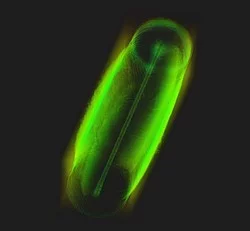Miniaturizing fluidic circuitry is critical to manipulate small amounts of liquids. Standard solid walls solutions are limited by flow rates and plagued by fouling. The team of Prof. Thomas Hermans at the University of Strasbourg in France managed to create wall-less aqueous liquid channels (called anti-tubes). In an immiscible magnetic liquid stabilized by a quadrupolar magnetic field, the diameter of those channels can be controlled and could reach dimensions as small as one micrometer with controlled flow rate. This new technique will change the way of manipulating small amounts of liquids like it is the case in fluid dynamics, pharmaceutical processes or more practically in the traditional peristaltic pump used to pump blood through the heart during surgery. A 3D rendering of an anti-tube, a stable 81 μm diameter water channel bounded by MD4 ferrofluid is shown in the figure.
Original Publication
Liquid flow and control without solid walls
Dunne P, Adachi T, Dev AA, Sorrenti A, Giacchetti L, Bonnin A, Bourdon C, Mangin PH, Coey JMD, Doudin B & Hermans TM
Nature, 581(7806), 58-62 (2020).
Contact
Dr. Anne Bonnin
Beamline Scientist, Swiss Light Source
Paul Scherrer Institut
Telephone: +41 56 310 4678
E-mail: anne.bonnin@psi.ch
